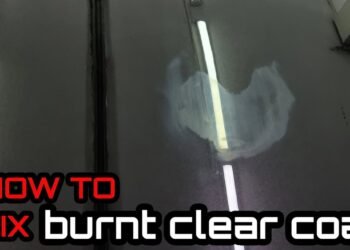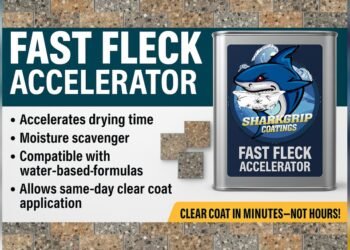Are you wondering if Bondo will stick to plastic when you need to fix a cracked bumper or trim? You’re not alone.
Many people try to use regular body filler on plastic parts, only to find it cracks or peels off soon after. The truth is, not all fillers are made the same. If you want a repair that lasts and looks smooth, you need to understand how Bondo interacts with plastic surfaces—and why flexibility in the filler matters.
Keep reading, and you’ll discover exactly what type of Bondo works best on plastic, how to prepare your surface for a strong bond, and the simple steps to get professional-looking results every time. Don’t risk a quick fix that fails—learn how to make your plastic repair stick for good.

Credit: www.youtube.com
Bondo And Plastic Compatibility
Bondo is a popular body filler known for repairing dents and holes. Many wonder if Bondo sticks well to plastic surfaces. The answer depends on the type of plastic and the Bondo product used. Standard Bondo is rigid and made for metal or fiberglass, which can cause issues on flexible plastic parts.
Plastic parts like bumpers and trim often bend and flex. Using the wrong filler can lead to cracks and poor adhesion. Specialized fillers designed for plastic provide better results. Understanding how Bondo interacts with plastic helps ensure a durable repair.
Why Flexibility Matters
Plastic parts flex with movement and temperature changes. Rigid fillers cannot bend and will crack over time. Flexible fillers move with the plastic, preventing damage. This flexibility keeps the repair intact and extends its life. Choosing a flexible product is key for plastic surfaces.
Risks Of Using Rigid Fillers
Rigid fillers like standard Bondo harden and become brittle. When applied to plastic, they may not bond well. Cracks form as the plastic moves and the filler does not. This leads to poor appearance and weak repairs. Repairs with rigid fillers often fail quickly on plastic parts.

Credit: www.amazon.com
Types Of Plastic Fillers
Plastic fillers come in different types to match various repair needs. Choosing the right filler is key for a strong, lasting fix. Plastic parts like bumpers and trim require products that stick well and stay flexible. Standard fillers made for metal often fail on plastic. Below are the main types of plastic fillers you can use.
Flexible Plastic Body Fillers
Flexible plastic body fillers are made to bend with plastic parts. They usually contain polyester resin mixed with a hardener. This mix cures to a tough but flexible finish. These fillers are perfect for bumpers and panels that move slightly. They prevent cracks and peeling that rigid fillers cause. Bondo offers flexible fillers designed for automotive plastics.
Plastic Repair Adhesives
Plastic repair adhesives work like glue and filler combined. They bond plastic pieces firmly while filling gaps or cracks. These adhesives remain flexible after drying, which helps absorb shocks. Many are two-part epoxies or urethanes. Plastic repair adhesives are ideal for fixing broken or cracked parts. They provide a durable, smooth surface for sanding and painting.
Products Designed For Automotive Plastics
Some fillers are specially formulated for automotive plastics. These products consider the unique needs of car bumpers, trims, and moldings. They offer excellent adhesion and flexibility to handle temperature changes and road vibrations. Brands like Eastwood and Bondo make fillers that work well on flexible plastic parts. Using these ensures a professional finish and longer-lasting repairs.
Choosing The Right Filler
Choosing the right filler is key for a lasting repair on plastic surfaces. Using the wrong filler can cause cracks or poor adhesion. This section helps you pick the best filler for different plastic types. Understanding your plastic and filler options saves time and ensures a smooth finish.
Identifying Plastic Types
First, know the plastic you want to fix. Plastics can be rigid or flexible. Rigid plastics are hard and do not bend easily. Flexible plastics can stretch or bend without breaking. Most car bumpers and trim use flexible plastic. Identifying the plastic type helps choose the correct filler. Look for markings or ask a professional if unsure.
Matching Fillers To Plastic Flexibility
Match the filler to the plastic’s flexibility. Use flexible fillers for flexible plastics. These fillers move with the plastic and prevent cracks. Rigid fillers work only on hard, non-flexible plastics. Flexible fillers often contain special resins or adhesives. Brands like Bondo make flexible fillers for plastic bumpers. Always follow product instructions for best results.
Surface Preparation
Surface preparation plays a crucial role in whether Bondo will stick to plastic. Proper preparation creates a strong bond between the filler and the plastic surface. Without it, the filler may peel or crack over time.
Cleaning and scuffing the plastic surface remove dirt and create texture. This allows the Bondo to grip the plastic firmly. Skipping these steps reduces adhesion and durability.
Cleaning And Drying
Start by cleaning the plastic surface thoroughly. Use soap and water or a plastic-safe cleaner. Remove all grease, oil, and dirt particles.
Rinse the area well and let it dry completely. Moisture trapped under the filler can cause adhesion failure. Drying ensures the surface is ready for the next step.
Scuffing For Better Adhesion
Use fine-grit sandpaper to scuff the plastic surface gently. This creates tiny grooves that help the filler stick better.
Sand evenly across the repair area. Avoid over-sanding, which can damage the plastic. After scuffing, wipe away dust with a clean cloth.
Application Process
The application process for Bondo on plastic surfaces needs care and precision. Proper preparation and correct mixing ensure better adhesion and lasting repair. Following the right curing guidelines helps maintain the filler’s flexibility and strength. These steps increase the chance that Bondo will stick well to plastic parts.
Mixing And Applying Filler
Start by cleaning the plastic surface thoroughly. Remove dirt, grease, and loose particles. Lightly sand the area with fine-grit sandpaper for better grip. Mix the Bondo filler with the hardener in the recommended ratio. Stir well until the color is uniform. Apply the mixture quickly using a spreader or putty knife. Work in thin layers to avoid cracking. Shape and smooth the filler before it hardens.
Curing Guidelines
Allow the filler to cure at room temperature. Avoid touching or moving the repair area during this time. The curing usually takes 15 to 30 minutes depending on conditions. Do not rush sanding or painting until the filler is fully hardened. Proper curing keeps the filler flexible and bonded to plastic. Follow the manufacturer’s instructions closely for best results.
Common Mistakes To Avoid
Using Bondo or any body filler on plastic parts requires care. Many users make mistakes that cause poor adhesion or cracking. Avoiding these errors improves repair quality and durability. Understanding common pitfalls helps you choose the right methods and products for plastic repair.
Using Metal Fillers On Plastic
Metal fillers are hard and rigid. They do not bend with plastic parts. Applying metal-based Bondo on plastic can cause cracks. The filler may peel off after curing. Always select a flexible filler made for plastic. This keeps the repair strong and prevents damage.
Ignoring Plastic Movement
Plastic parts expand and contract with heat. They also flex when the vehicle moves. Ignoring this movement causes filler to separate. Using rigid materials on flexible surfaces leads to failure. Use fillers designed to flex with the plastic. This avoids cracks and maintains adhesion over time.
Recommended Products
Choosing the right product is vital for repairing plastic surfaces effectively. Not all fillers work well with plastic. Some crack or peel because they lack flexibility. Products made for plastic offer better adhesion and durability. They move with the plastic instead of breaking apart. Below are some recommended products designed to stick and stay on plastic parts.
Bondo Flexible Part Repair
Bondo Flexible Part Repair is made for plastic repairs. It is a flexible polyester filler that does not crack. It bonds well to bumpers and trim pieces. This product sands easily and holds paint well. It cures quickly, allowing faster repairs. Its flexibility helps it stay intact under stress.
Eastwood Contour Flexible Body Filler
Eastwood Contour Flexible Body Filler works on many plastic surfaces. It is soft enough to flex with the part. It resists cracking even after bending. This filler is great for automotive plastics and trim. It also offers good adhesion and smooth finishes. Eastwood’s formula supports long-lasting repairs.
3m Plastic Repair Solutions
3M offers a range of plastic repair products. Their solutions include flexible fillers and adhesives. These products bond strongly to plastic parts. They maintain flexibility after curing to prevent cracks. 3M repair kits often come with surface prep materials. This ensures better adhesion and a cleaner finish.
Tips For Long-lasting Repairs
Making repairs last on plastic surfaces requires careful attention. Using the right materials is just the start. Proper techniques help keep repairs strong and durable over time.
Follow these tips to maintain the bond and avoid cracks or peeling. Small steps during and after repair make a big difference.
Maintaining Flexibility
Plastic parts often bend or flex during use. Rigid fillers crack easily on flexible surfaces. Choose a flexible plastic body filler for repairs. These fillers move with the plastic without breaking.
Keep the repaired area flexible by avoiding over-sanding. Sand lightly to smooth, but do not remove too much filler. Avoid applying heavy paint layers that can harden the surface. Use flexible paints designed for plastic to keep elasticity.
Post-repair Finishing Techniques
After the filler cures, prepare the surface carefully. Clean the area to remove dust and oils. Use fine-grit sandpaper for a smooth finish. This helps paint stick better and prevents peeling.
Apply a primer made for plastic surfaces. This step improves adhesion and durability. Finish with paint that matches the plastic’s flexibility. Allow each coat to dry fully before adding another. Proper finishing protects the repair and extends its life.

Credit: megdeldesign.com
Frequently Asked Questions
What Kind Of Body Filler To Use On Plastic?
Use a flexible plastic body filler designed for automotive plastics or a plastic repair adhesive. Avoid rigid fillers to prevent cracking. Brands like Bondo and Eastwood offer suitable flexible fillers for bumpers and trims. Always prepare the surface and follow product instructions for best results.
Can Bondo Stick To Plastic?
Bondo can stick to plastic only if you use a flexible plastic body filler variant. Standard Bondo for metal cracks on plastic. Clean and scuff the surface before application for better adhesion. Choose products designed for automotive plastics like bumpers for durable repairs.
What Filler Will Stick To Plastic?
Flexible plastic body fillers, like Bondo Bumper Repair or Eastwood Flexible Body Filler, bond well to plastic. These fillers stay flexible after curing, preventing cracks on plastic parts such as bumpers and trim. Always clean and scuff the surface before application for best adhesion.
What Filler Is Best For Plastic?
The best filler for plastic is a flexible plastic body filler designed for automotive plastics. It adheres well and flexes with the part, preventing cracks. Brands like Bondo and Eastwood offer flexible polyester fillers and plastic repair adhesives ideal for bumpers and trim.
Does Bondo Stick Well To All Types Of Plastic?
Bondo sticks best to rigid plastics but may not bond well with flexible plastics.
Conclusion
Bondo can stick to plastic, but choose the right type carefully. Use flexible plastic body fillers designed for automotive plastics. These fillers bond well and move with the plastic, preventing cracks. Always clean and prepare the surface before applying any filler.
Rigid fillers may crack and fail on plastic parts. Following the right steps ensures a strong, lasting repair. This keeps your plastic looking good and prevents future damage.

















